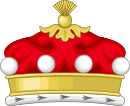| Baron O'Neill | |
|---|---|
  Blazon
| |
| Creation date | 18 April 1868 |
| Created by | Queen Victoria |
| Peerage | Peerage of the United Kingdom |
| First holder | William O'Neill, 1st Baron O'Neill |
| Present holder | Raymond O'Neill, 4th Baron O'Neill |
| Heir apparent | Shane Sebastian Clanaboy O'Neill |
| Status | Extant |
| Seat(s) | Shane's Castle |
| Motto | Above the Crests: INVITUM SEQUITUR HONOS(Honours follow us without seeking) Below the shield: LAMH DEARG EIRIN(The Red Hand of Ireland) |
Baron O'Neill, of Shane's Castle in the County of Antrim, is a title in the Peerage of the United Kingdom. [1] It was created in 1868 for the musical composer The Reverend William O'Neill. Born William Chichester, he succeeded to the estates of his cousin John Bruce Richard O'Neill, 3rd Viscount O'Neill, in 1855 (on whose death the viscountcy and first barony of O'Neill became extinct) and assumed by royal licence the surname of O'Neill in lieu of Chichester in order to inherit the lands of his cousin, despite not being descended in the male line from an O'Neill. [2] The Chichesters trace their lineage to the name O'Neill through Mary Chichester, daughter of Henry O'Neill of Shane's Castle. Lord O'Neill was the patrilineal great-great-great-grandson of John Chichester, younger brother of Arthur Chichester, 2nd Earl of Donegall. [3] The latter two were both nephews of Arthur Chichester, 1st Earl of Donegall, and grandsons of Edward Chichester, 1st Viscount Chichester (see the Marquess of Donegall for more information). Lord O'Neill was succeeded by his eldest son, the second Baron. He sat as a Conservative Member of Parliament for Antrim.
Contents
His eldest son and heir apparent, the Hon. Arthur O'Neill, represented Antrim Mid in the House of Commons as a Conservative from 1910 until 1914, when he was killed in action during the First World War, the first MP to die in the conflict. The second Baron was therefore succeeded by his grandson, Shane O'Neill, 3rd Baron O'Neill (the son of the Hon. Arthur O'Neill). He was killed in action in Italy during the Second World War. The title is currently held by his son, the fourth Baron, who succeeded in 1944. He was Lord Lieutenant of Antrim from 1994 to 2008.
Two other members of the O'Neill family have been elevated to the peerage. Hugh O'Neill, 1st Baron Rathcavan, was the youngest son of the second Baron O'Neill, while Terence O'Neill, Baron O'Neill of the Maine, Prime Minister of Northern Ireland, was the youngest brother of the third Baron.
The holders of the O'Neill and Rathcavan baronies are in the remainder of the titles Earl of Donegall, Viscount Chichester and Baron Chichester, though the chances of that happening are very slim.
The family seat is Shane's Castle, near Randalstown, County Antrim.
